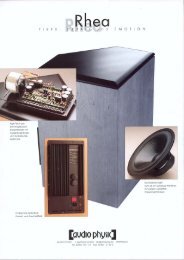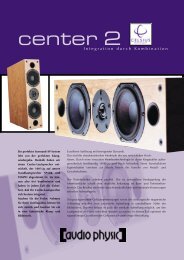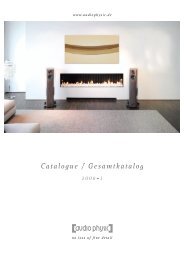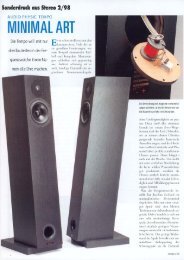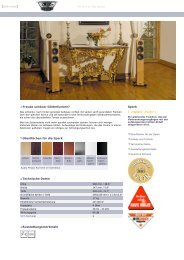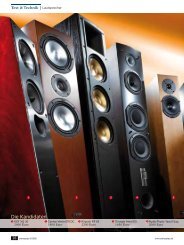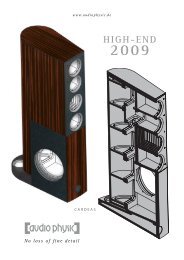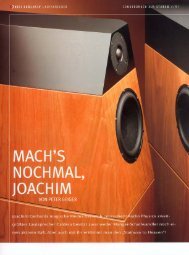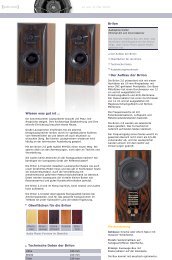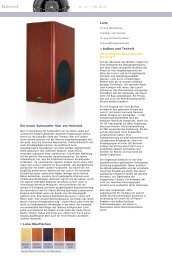Stereo - Audio Physic
Stereo - Audio Physic
Stereo - Audio Physic
You also want an ePaper? Increase the reach of your titles
YUMPU automatically turns print PDFs into web optimized ePapers that Google loves.
TEST LAUTSPRECHER<br />
IM REICH<br />
DER MITTEN<br />
Die schlanke Form mit dem<br />
oben sitzenden Mittel- und<br />
Hochtöner sowie den seit-<br />
lich eingesetzten Bässen<br />
zeichnete stets die Virgo aus.<br />
Oben die zweite von 1995,<br />
darunter die Virgo 3 (2001)<br />
22 STEREO 10/2007<br />
Die Virgo stellte immer etwas<br />
Besonderes im Programm von<br />
<strong>Audio</strong> <strong>Physic</strong> dar. Sie war das<br />
Verbindungsglied<br />
zu den<br />
großen Modellen<br />
und Technologieträger.<br />
Die aktuelle<br />
Version macht<br />
da keine Ausnahme.<br />
Ist sie<br />
erneut ein<br />
großer Wurf?<br />
STICHWORT<br />
elastischer Ring<br />
Wie der Finger an einem<br />
Glöckchen dämpft der<br />
Ring Klingelresonanzen.<br />
<strong>Audio</strong> <strong>Physic</strong> nennt<br />
diese Weise der Bewegungshemmung<br />
„Active<br />
Cone Damping II“.<br />
von Matthias Böde<br />
Nanu, haben wir da etwa eine Generation<br />
verpennt? Bis dato gab’s<br />
doch erst die dritte Version von<br />
<strong>Audio</strong> <strong>Physic</strong>s Erfolgstyp Virgo. Und nun<br />
steht schon Nummer fünf da? Jawohl, denn<br />
aus Rücksicht auf die asiatischen Märkte,<br />
wo die Vier eine Unglückszahl ist, übersprang<br />
man sie einfach. Sowas nennt man<br />
wohl Globalisierung, ohne die die aktuelle<br />
Virgo ohnehin kaum denkbar wäre.<br />
Einerseits ist die Virgo seit ihrem ersten<br />
Auftreten einer der erfolgreichsten Exportartikel<br />
des Lautsprecherspezialisten aus<br />
dem sauerländischen Brilon. Ob nun das<br />
europäische Ausland, die USA oder eben<br />
die ohnehin hifi-verrückten Asiaten –<br />
alle schätzen die Möglichkeit, zum<br />
noch überschaubaren Preis ein<br />
großes Stück vom <strong>Audio</strong>-<strong>Physic</strong>-<br />
Klang zu erwerben. Die Virgo sei<br />
„High End fürs Volk“, fasste<br />
STEREO seine Erfahrungen<br />
ein ums andere Mal zusammen.<br />
Und so darf es nach<br />
Ansicht des Herstellers<br />
auch bleiben.<br />
Dafür muss er<br />
stets etwas Neues<br />
bieten und seinen Anspruch<br />
beweisen. Den alten, aber<br />
nach wie vor gültigen Slogan „No loss of fine<br />
detail“ soll nun der „Hyper-Holographic-Cone-Mitteltöner“<br />
mit neuem Leben<br />
füllen. Auch er wäre unabhängig von<br />
seinem „denglischen“ Namen ohne<br />
die Globalisierung nicht möglich,<br />
denn er kommt – dreimal dürfen wir<br />
raten – aus China. Ach nee, da kaufen<br />
die Gralshüter des Reinklangs für ihre<br />
Mitten jetzt also ebenfalls Billig-<br />
Chassis aus dem Reich der Mitte!<br />
Bevor Sie voreilige Schlüsse ziehen,<br />
hören Sie die ganze Geschichte: Ein<br />
Mitteltöner wie der HHCM schwebte <strong>Audio</strong><br />
<strong>Physic</strong>s Entwicklungschef Manfred<br />
Diestertich schon lange vor. Er wusste genau,<br />
wie er konstruiert sein sollte. Allein,<br />
von den eingesessenen skandinavischen<br />
Lieferanten wollte ihm keiner seinen<br />
Traum bauen.„Zu kompliziert, zu aufwän-<br />
„No Loss of fine<br />
Detail“ – der Slogan<br />
bekommt durch den radikalen<br />
Mitteltöner<br />
neue Bedeutung<br />
dig, bringt doch eh nichts“, lauteten die<br />
Ausflüchte. So ging das, bis Diestertich eine<br />
neue, engagiertere Quelle auftat. Wavecor<br />
im Hongkonger Hinterland war bereit, den<br />
Auftrag zu übernehmen. Und eigentlich<br />
entfernte man sich gar nicht so weit vom<br />
Gewohnten, denn das noch junge Unternehmen<br />
wurde vom ehemaligen Vifa-Entwicklungsleiter,<br />
dem Dänen Allan Isaksen,<br />
gegründet, so dass ein hoher Qualitätsstandard<br />
praktisch selbstverständlich ist.<br />
Die Schikane, vor der mancher erfahrene<br />
Chassis-Produzent zurückschreckte: Der<br />
HHCM sollte gleich zwei ineinander verschachtelte<br />
Körbe haben. Einen aus Kunst-<br />
Doppelt gemoppelt hält besser. Der „Hyper-<br />
Holographic-Cone-Mitteltöner“ besitzt zwei<br />
Körbe, innen aus Kunststoff, außen aus Metall<br />
stoff sowie einen aus Metall, die dort zum<br />
Einsatz kommen, wo sie ihre spezifischen<br />
Vorzüge am besten ausspielen können.<br />
Die bewegten Komponenten wie die<br />
durch einen elastischen Ring, der sie umspannt,<br />
am Resonieren gehinderte Aluminiummembran<br />
samt Sicke, Zentrierung<br />
und Schwingspule trägt ein auf hohe innere<br />
Dämpfung ausgelegter Innenkorb aus<br />
Kunststoff. Der äußere Korb aus Alu-<br />
Druckguss umschließt den kräftigen Neodym-Magneten<br />
und leitet die Antriebswärme<br />
in große Kühlrippen ab, verbliebene<br />
Schwingungen werden über schmale, steife<br />
Stege zum Befestigungsring geführt.<br />
Diestertich versprach sich von dem Materialmix<br />
optimale Resonanzarmut in Verbindung<br />
mit mechanischer und thermischer<br />
Stabilität. Antriebs- und Gehäuseschwingungen<br />
sollten effektiv von der<br />
Membran ferngehalten und gleichzeitig die<br />
Belastbarkeit des Töners gesteigert werden.<br />
Akustisch erhoffte er sich höchstes Auflösungsvermögen,<br />
das mit maximaler Verfärbungsfreiheit<br />
einhergeht.<br />
10/2007 STEREO 23
TEST LAUTSPRECHER<br />
Wir wollen Sie nicht auf die Folter spannen.<br />
Der Mitteltöner funktioniert hervorragend.<br />
Während die Hersteller sonst eher<br />
besonderen Wert auf die Hoch- und/oder<br />
Tieftonchassis legen, konzentrierte sich <strong>Audio</strong><br />
<strong>Physic</strong> konsequent auf den Bereich, in<br />
dem unser Ohr am empfindlichsten ist. Mit<br />
dem schon zuvor eingesetzten „Hyper Holographic<br />
Cone Tweeter“, dessen Schallaustritt<br />
von einem dünnen Schaumstoffring<br />
eingefasst ist, sowie den beiden ebenfalls<br />
mit Alumembranen bestückten, über eine<br />
Reflexöffnung im Boxenboden beatmeten<br />
Woofern im unteren Gehäuseteil haben die<br />
Sauerländer ihrem Highlight starke Partner<br />
zur Seite gestellt, die von besagten Skandinaviern<br />
stammen und im Sauerland den<br />
letzten Schliff erhalten.<br />
Nach längerem Einspielen, jedes Chassis<br />
wird vor dem Einbau und ohne beschneidende<br />
Weiche „vorbehandelt“, stellten wir<br />
die neue Virgo mit Munyungo Jacksons<br />
„Columbiana“ auf die Probe, einer komplexen<br />
VTL-Aufnahme, bei der viele<br />
Musiker in einem ganz mit Ze-<br />
dernholz ausgeschlagenen Saal spielen, was<br />
dem dichten wie räumlichen Klangbild zusätzlich<br />
eine spezifische tonale Note verleiht.<br />
Dabei wurde schnell klar, worauf sich<br />
„Hyper Holographic“ in der kryptischen<br />
Bezeichnung der Mittel- und Hochtöner<br />
bezieht: auf ihre exemplarisch dreidimensionale<br />
und gerade in die Tiefe ungewohnt<br />
plastisch gestaffelte Darstellung des musikalischen<br />
Geschehens. So gelöst und von<br />
Beschränkungen befreit haben wir das<br />
Stück selten gehört. Federleicht flirrten die<br />
Gitarren, und die Klarheit, mit der sogar<br />
weit hinten spielende Instrumente abgebildet<br />
wurden, führte tatsächlich zu einer Art<br />
24 STEREO 10/2007<br />
Die zweiteilige Weiche<br />
ist mit vielen Bauteilen nach<br />
<strong>Audio</strong> <strong>Physic</strong>s Vorgaben bestückt. Die für die<br />
oberen Lagen (l.) sitzt in der Mitteltönerkammer<br />
<strong>Audio</strong> <strong>Physic</strong>s neuer<br />
Mitteltöner arbeitet<br />
in genau dem Bereich, in<br />
dem das Ohr besonders<br />
empfindlich ist<br />
holografischem Effekt, den man von anderen<br />
Lautsprechern so nicht kennt.<br />
Zwei meiner Favoriten in dieser Klasse<br />
sind B&Ws 804S, die mit dem berühmten,<br />
gelben, sickenlosen Töner der Briten ebenfalls<br />
besondere Anstrengungen für die Mitten<br />
betreibt, sowie die Contour S3.4 von<br />
Dynaudio. Letztere besitzt als 2,5-Wege-<br />
System gar kein spezielles Mitteltonchassis,<br />
besticht aber jedes Mal aufs Neue mit ihrer<br />
Definition und Neutralität.<br />
Potente Gegner,<br />
mit denen<br />
die Virgo kein<br />
leichtes Spiel hatte.<br />
Doch gerade in<br />
den Mitten<br />
konnte sie<br />
den Punktsieg<br />
für sich<br />
verbuchen. Tonal<br />
sonor und mit einem wunderbar<br />
bruchlosen Übergang zum<br />
Grundton hin gesegnet, war der HHCM<br />
in Sachen Auflösung, Präzision und Durchsichtigkeit<br />
letztlich nicht zu schlagen. Selbst<br />
B&Ws großer Gelber konnte da nicht ran,<br />
verklumpte die Töne ganz leicht miteinander,<br />
was schon reichte, um sie schwerer und<br />
weniger gelöst erscheinen zu lassen und so<br />
bei aller Qualität die phantastische Natürlichkeit<br />
der <strong>Audio</strong> <strong>Physic</strong> zu verpassen.<br />
Wie Dynaudio es<br />
schafft, trotz fehlendemMittenspezialisten<br />
eine<br />
derartig leichtfüßige<br />
und unaffektierteWiedergabe<br />
zu erzielen,<br />
bleibt das Geheimnis<br />
der Dänen. Sie<br />
Anstelle der mitgelie-<br />
ferten Spikes oder<br />
Gleiter (r,) empfehlen<br />
wir <strong>Audio</strong> <strong>Physic</strong>s neue<br />
VCF-Füße. Der Aufpreis<br />
von 200 Euro für acht<br />
Stück lohnt unbedingt<br />
musste sich vor allem dem Schmelz und<br />
farbigen Charme der Virgo geschlagen geben.<br />
Die S3.4 klingt nüchterner, etwas steifer<br />
und weniger vielschichtig, was vor allem<br />
bei Christy Barons Gesang auffiel.<br />
Dazu passt der differenzierte, kernige Bass<br />
der Virgo, der auf Schnelligkeit und Präzision<br />
gezüchtet ist. Und auch ihr HHCT-<br />
Höhenakrobat passt perfekt zur grazilen<br />
Stämmigkeit – jawohl, sowas gibt’s – des<br />
Mitteltöners. Das Ergebnis des Zusammenspiels<br />
ist die absolut schlüssige Verbindung<br />
von rasiermesserscharfer Klarheit und vollmundiger,<br />
aber keinesfalls „pausbäckiger“<br />
Homogenität.<br />
In vollständiger<br />
Pracht zeigte<br />
sich die betörendeGeschlossenheit<br />
aber nur<br />
dann, wenn die<br />
von <strong>Audio</strong> <strong>Physic</strong>mitgeschickten,<br />
jedoch nicht<br />
zum Lieferumfang<br />
gehörenden<br />
TEST-KETTE<br />
(SA)CD-SPIELER: NAD<br />
M5, Rega Apollo<br />
VOLLVERSTÄRKER:<br />
Marantz PM-11S1, Prima<br />
Luna Dialogue One<br />
VOR-/ENDSTUFE: Soulution<br />
720/710<br />
LAUTSPRECHER: B&W<br />
804S, Dynaudio C. S3.4<br />
sowie brandneuen „Vibration Control<br />
Feet“, kurz VCF, anstelle der Spikes oder nur<br />
zum Hin- und Herrücken empfehlenswerten<br />
gummierten Füße in die Acht-Millimeter-Gewinde<br />
der soliden Aluminiumausleger<br />
montiert waren. Die benötigten acht<br />
Stück kosten rund 200 Euro, die für die Virgo<br />
fest einkalkuliert werden sollten.<br />
Die mit einem speziellen Gewebe realisierten<br />
VCF basieren auf der bewährten<br />
SSC-Technik, die sämtliche Schwingungen<br />
in Zugenergie umwandelt. Auf den beigepackten<br />
Spikes blieben die Vorzüge von<br />
HHCT und HHCM zwar grundsätzlich erhalten,<br />
doch das Spektrum orientierte sich<br />
nun stärker um die Gehäuse herum, stand<br />
nicht mehr so frei im<br />
Raum, und die zuvor bei<br />
höchster Auflösung cremezarten<br />
Höhen verloren einen Teil<br />
ihrer samtenen Finesse, gerieten<br />
plötzlich rauer. Es bildeten<br />
sich feine Zacken und Kanten,<br />
die vorher nicht dagewesen<br />
waren, und dabei war es völlig<br />
egal, ob die Boxen auf weicherem<br />
oder härterem Untergrund<br />
betrieben wurden. Bitte<br />
an <strong>Audio</strong> <strong>Physic</strong>: Macht die<br />
Virgo etwas teurer und legt die VCF gleich<br />
mit in den Karton. Dann versteht garantiert<br />
jeder, was „No loss of fine detail“ meint.<br />
Schließlich wird der Käufer ja auch nicht<br />
gefragt, ob er den Perfect Sound-Chip haben<br />
will, der auf der Rückseite des HHCM<br />
klebt. Jawohl, Sie haben richtig gelesen, <strong>Audio</strong><br />
<strong>Physic</strong> setzt den geheimnisvollen Chip<br />
ein, der in STEREO schon für Furore sorgte<br />
und gerade in Sicherungskästen oder auf<br />
Geräten schon Erstaunliches bewirkte. Wie<br />
viele unserer Leser experimentierte Diestertich<br />
mit ihm und war von den Resultaten<br />
so angetan, dass er beschloss, dass es Chip-<br />
Tuning ab sofort auch bei Boxen gibt, wobei<br />
eine speziell auf Lautsprecher zugeschnittene<br />
Version zum Einsatz kommen soll.<br />
Egal, was Sie davon halten, dürfen Sie sicher<br />
sein, dass der Mann nie gegen seine<br />
Überzeugung handeln würde. Abseits solch<br />
skurril anmutender Ansätze gibt’s in der<br />
neuen Virgo jede Menge physikalische, zu<br />
denen auch die wie ein Diffusor gestalteten<br />
Wände des<br />
HHCM-Gehäuses<br />
zählen.<br />
Er ist der Star<br />
in dem starken<br />
Chassis-Quartett,<br />
das den Hörer<br />
in die Welt<br />
des Klangs entführt<br />
und nicht<br />
nur ins Reich der<br />
Mitten.<br />
Single-Wiring mit<br />
WBT-Nextgen-Buch-<br />
sen vermeidet Klang-<br />
verluste durch ein<br />
Mehrpol-Terminal. Bi-<br />
Wiring gibt’s aber<br />
auch – auf Bestellung<br />
AUDIO PHYSIC VIRGO V<br />
Paar um €6000<br />
Maße: 23 x 99 x 40 cm (BxHxT)<br />
Garantie: 10 Jahre<br />
Vertrieb: <strong>Audio</strong> <strong>Physic</strong>,<br />
Tel.: 02961/96170<br />
www.audiophysic.de<br />
Auch dank ihres Doppelkorb-Mitteltöners<br />
realisiert die neue Virgo<br />
ein ungemein facettenreiches,<br />
homogenes und räumlich bestechend<br />
realistisches, ja zuweilen<br />
fast holographisches Klangbild. Damit<br />
steht sie in bester Virgo-Tradition, die sie<br />
zu bisher unerreichten Höhen führt. Selbst<br />
die tolle Dritte war nicht so brisant.<br />
LABOR<br />
FREQUENZGANG/IMPEDANZ<br />
SPRUNGANTWORT<br />
„Da kommt mehr, als das Diagramm ausweist“,<br />
sagte STEREO-Messtechniker Rolf<br />
Hähle und meinte den Bassbereich. Aufgrund<br />
der seitlich eingesetzten Chassis<br />
der Virgo, des weiten Abstands zu den Seitenwänden<br />
in unserem Messraum sowie<br />
des kurzen Zeitfensters, das Reflexionen<br />
weitgehend ausblendet, wird in der Grafik<br />
ein Teil der Energie unterschlagen. Die im<br />
unkritischen Impedanzgang sichtbare,<br />
saubere 25-Hertz-Abstimmung zeigt, wo<br />
es langgeht. Bis auf einen Dip bei zwei Kilohertz<br />
sehr linear, prima Rundstrahlverhalten<br />
(gestrichelte Linie), präzise Sprungantwort<br />
ohne erkennbare Resonanzen.
LOUDSPEAKER TEST<br />
THE MIDRANGE<br />
KINGDOM<br />
The slim design with tweeter<br />
and midrange driver in the<br />
upper unit of the baffle and<br />
side-firing woofers has always<br />
been the hallmark of the Virgo.<br />
See above the Virgo 2 of 1995<br />
and below the mark 3 incarnation<br />
of the Virgo of 2001.<br />
The Virgo has always held a special<br />
place in the <strong>Audio</strong> <strong>Physic</strong> product<br />
range serving as a perfect link to<br />
the larger<br />
models and<br />
incorporating<br />
sophisticated<br />
technology. The<br />
latest version<br />
does not fall<br />
short of the mark.<br />
Has the new<br />
Virgo hit the<br />
big time again?<br />
KEY WORD<br />
elastic ring<br />
The ring helps damp<br />
ringing resonances in<br />
much the same manner<br />
as the sound of a bell is<br />
muted by touching it<br />
with one’s finger. The<br />
<strong>Audio</strong> <strong>Physic</strong> solution<br />
to tension the diaphragm<br />
is named „Active<br />
Cone Damping II“.<br />
by Matthias Böde<br />
Have we really jumped a Virgo generation without<br />
even realising it? To date we have been aware of<br />
the existence of a third version of the loudspeaker<br />
which has long become an <strong>Audio</strong> <strong>Physic</strong><br />
benchmark for success. And now the fifth<br />
incarnation of the Virgo is standing before us. Yes<br />
you heard right! In response to Asian markets –<br />
many Asians believe that the number four is<br />
unlucky - <strong>Audio</strong> <strong>Physic</strong> took a jump from number<br />
three to number five. We figure that is what<br />
globalisation is all about, and without access to<br />
global resources the brand-new Virgo could not<br />
have possibly been built.<br />
With a proven track record since its first design,<br />
the Virgo has become one of the most successful<br />
export hits of the Brilon based German<br />
loudspeaker manufacturer.<br />
<strong>Audio</strong>philes in Europe and in the USA as well as<br />
Asians, bubbling over with enthusiasm<br />
for all things hi-fi, simply love the opportunity<br />
to buy a still affordable loudspeaker<br />
where <strong>Audio</strong> <strong>Physic</strong>’s strength in sound<br />
reproduction is present in abundance.<br />
In the light of the experience we have<br />
gained, STEREO has always held<br />
to the firm belief that the Virgo is<br />
“high end for the people“,<br />
which is - the manufacturer<br />
could not agree more -<br />
how it should be now<br />
and in the future. Part of the<br />
deal is of course that <strong>Audio</strong> <strong>Physic</strong> must come<br />
up with something new each time to assert its claim.<br />
The "no loss of fine detail" slogan has served as a<br />
source of inspiration for years and is still going<br />
strong, filled with new life by the advent of the “Hyper<br />
Holographic Cone Mitteltöner (HHCM). The name is<br />
a combination of English and German, with<br />
Mitteltöner being the German word for<br />
midrange driver, and just another sign of the<br />
growing globalisation for it is not hard to<br />
guess. where the HHCM is produced – yes,<br />
in China. The times are changing. It would<br />
seem that those who have always spoken<br />
out on musical truth as the Holy Grail of<br />
midrange performance have also started to<br />
shop for low-price drivers in the Middle<br />
Kingdom.<br />
It is important not to jump to conclusions before<br />
you know the whole story: For <strong>Audio</strong> <strong>Physic</strong>’s<br />
chief designer Manfred Diestertich, a midrange<br />
driver such as the HHCM had been in the air for<br />
quite a while. He knew exactly how to build it.<br />
With the new radical<br />
midrange driver, <strong>Audio</strong><br />
<strong>Physic</strong>’s “no loss of fine<br />
detail” slogan is filled<br />
with new meaning.<br />
However the long-established Scandinavian<br />
suppliers did not come to his aid in order to<br />
make his dream come true. “Too complicated,<br />
too much work, not worth the effort,” was the<br />
common response to his plea. That is how it<br />
went until Diestertich struck gold and found a<br />
new, highly committed partner. Wavecor, a<br />
company located in Hong Kong’s back-country,<br />
was ready to take on the job. As a matter of<br />
fact, the decision was not too far off the mark.<br />
The young and upcoming company was<br />
actually founded by Allan Isakson from<br />
Denmark, the former head of development at<br />
Vifa, ensuring the upholding of high quality<br />
standards.<br />
It was the following task which many<br />
experienced driver manufacturers had shied<br />
away from early on: The HHCM was meant to<br />
Double stitching lasts longer. The “Hyper<br />
Holographic Cone Midrange Driver” features<br />
two baskets, a plastic inside basket and an<br />
outside basket made of metal.<br />
have two baskets nested into each other. One<br />
basket is made of plastic, the other consists of<br />
metal, and the two materials are used where<br />
they do their best in what they are best at doing.<br />
Moving parts such as the aluminium diaphragm,<br />
where an elastic ring designed to fit snugly around<br />
the rim helps to avoid resonances, together with<br />
the surround, the centering device and the voice<br />
coil are held in proper alignment by a plastic inside<br />
basket designed to achieve a maximum degree of<br />
damping inside. The powerful neodymium magnet<br />
is encased in an outside basket made of die-cast<br />
aluminium where the generated heat is efficiently<br />
dissipated by extensive cooling fins whereas<br />
remaining vibrations are transmitted to the<br />
mounting ring via slim stiff bridges.<br />
Diestertich had high hopes for the material mix,<br />
expecting it to have ultra-low resonance combined<br />
with mechanical and thermal stability. Driver and<br />
cabinet resonances are effectively kept away from<br />
the diaphragm while at the same time the stress<br />
behaviour of the midrange driver significantly<br />
improves. Sonically speaking, Diestertich hoped to<br />
achieve a perfect marriage of ultimate resolution<br />
performance and absolute freedom from<br />
coloration.<br />
22 STEREO 10/2007 10/2007 STEREO 23
LOUDSPEAKER TEST<br />
We do not want to keep you in the dark<br />
any longer: the midrange driver provides<br />
excellent performance. While other<br />
loudspeaker manufacturers give much<br />
thought to the tweeter and/or woofer<br />
configuration to distinguish them from the<br />
crowd, the <strong>Audio</strong> <strong>Physic</strong>’s focus is on the<br />
frequencies where the acoustic perception<br />
is the most sensitive. <strong>Audio</strong> <strong>Physic</strong> has<br />
revamped its top-class speaker with the<br />
previously introduced “Hyper Holographic<br />
Cone Tweeter“, affixed by a thin foam ring,<br />
as well as two bottom-mounted woofers,<br />
fitted with aluminium diaphragms and<br />
provided with a bass reflex port at the<br />
bottom of the cabinet giving them plenty of<br />
room to breathe. The high-performance<br />
components are manufactured by the<br />
aforementioned Scandinavian company<br />
and sent to <strong>Audio</strong> <strong>Physic</strong> for the final<br />
touches. After a longer burn-in period<br />
where each chassis is “pre-treated” before<br />
assembly and without a limiting crossover,<br />
we put the new Virgo to the test by<br />
playing Munyungo Jackson’s “Columbiana“,<br />
a highly complex VTL recording.<br />
The musicians perform in a hall<br />
Many components of the twopart<br />
crossover are custom-made for <strong>Audio</strong><br />
<strong>Physic</strong>. The one for the higher frequencies<br />
(left) is mounted in the midrange unit.<br />
panelled in cedar wood, adding an<br />
additional tonal glow to the already dense<br />
and spatial soundstage. It did not take us<br />
long to figure out what “Hyper Holographic”<br />
was supposed to mean when the somewhat<br />
cryptic names of the new midrange driver<br />
and tweeter were coined. Thanks to the<br />
exemplary three-dimensional music<br />
reproduction demonstrating a quite unusual<br />
spatial sound distribution in the lower<br />
ranges, the meaning became clear. We at<br />
STEREO have seldomly enjoyed such an<br />
uninhibited and utterly relaxed reproduction<br />
of the track. The sound of the plucked guitar<br />
strings seemed to float in the air, as light<br />
as a feather, and the clarity with which<br />
24 STEREO 10/2007<br />
<strong>Audio</strong> <strong>Physic</strong>’s new midrange<br />
driver operates exactly in the<br />
frequency range to which the<br />
ear is most sensitive.<br />
instruments further down the stage were<br />
portrayed lead to a kind of holographic<br />
effect which we have not experienced with<br />
other loudspeakers. Two of my favourite<br />
loudspeakers in this class, the B&W 804 S<br />
with the famous yellow driver, a design by<br />
the British manufacturer which is not<br />
supported in place by a surround, as well as<br />
Dynaudio's Contour S 3.4 also walk the<br />
extra mile when it comes to the midrange<br />
unit. As a two-and-a half way design, the<br />
Dynaudio does not feature a specific midrange<br />
driver<br />
chassis, and<br />
yet each time I<br />
hear it I am<br />
impressed by<br />
its definition<br />
and neutrality.<br />
Fierce enemies<br />
the both of<br />
them, and so<br />
the Virgo was facing<br />
a hard battle. However the<br />
loudspeaker fought back in the<br />
midrange unit and won on points. Blessed<br />
with tonal sonority and a wonderfully<br />
seamless transition to the woofer, the<br />
HHCM came out winner in the categories of<br />
resolution, precision and transparency.<br />
Even B&W’s yellow masterpiece could not<br />
hold a candle to the HHCM: it sounded<br />
slightly lumpy which was enough to make it<br />
seem heavier and less resolving of the<br />
musical texture. How on earch Dynaudio<br />
manages to achieve<br />
such a wonderfully<br />
airy and uninhibited<br />
sound reproduction<br />
despite the absence<br />
of a specific midrange<br />
design will<br />
remain the Danes’<br />
secret.<br />
Instead of the provided<br />
spikes or glider pads<br />
(right) we recommend<br />
<strong>Audio</strong> <strong>Physic</strong>’s new<br />
VCF high-end feet.<br />
With 200 Euro for 8<br />
VCF, they are worth<br />
every cent of their price.<br />
However even the Contour had to step<br />
back in line when the Virgo turned on its<br />
charm sounding smooth, sweet and<br />
colourful. The S 3.4’s style is more sober,<br />
a bit stiff and less diverse – this was<br />
especially noticeably when we were<br />
listening to Christy Baron’s voice.<br />
The differentiated and punchy bass of the<br />
Virgo, bred for speed and precision,<br />
proved a better match as well as the<br />
provided HHCT. Believe it or not, the highfrequency<br />
wizard is just perfectly married<br />
to the graceful stoutness of the midrange<br />
driver. The result of the marriage is an<br />
absolutely seamless blend of razor-sharp<br />
clarity and fullbodiedhomogeneity<br />
without<br />
any chubby<br />
quality to it. The<br />
Virgo’s awesome<br />
perfection<br />
was best enjoyed<br />
by us in<br />
its fullness after<br />
we had mounted<br />
the brand-new<br />
Associated<br />
Equipment<br />
(SA)CD-PLAYER: NAD<br />
M5, Rega Apollo<br />
INTEGRATED AMPLIFIER:<br />
Marantz PM-11S1, Prima<br />
Luna Dialogue One<br />
PREAMPLIFIER/AMPLIFIER:<br />
Soulution 720/710<br />
LOUDSPEAKER: B&W<br />
804S, Dynaudio C. S3.4<br />
“Vibration Control Feet”, courtesy of <strong>Audio</strong><br />
<strong>Physic</strong>, to the 0.3’’ (8 mm) sockets of the<br />
solid aluminium feet. The new VCF do not<br />
come with the Virgo, however they present<br />
a great alternative to spikes or rubber<br />
tipped pads, where the latter should only<br />
be used to move the loudspeaker around.<br />
With approx. 200 Euro for 8 VCF, they are<br />
worth every cent of their price and should<br />
definitely be purchased with the Virgo. The<br />
special material used for the Vibration<br />
Control Feet is based on the tried and<br />
tested SSC technology where all vibrations<br />
are translated into pull energy. With the<br />
delivered spikes, the advantages of HHCT<br />
and HHCM could still be enjoyed, however<br />
the spectrum was more focused around<br />
the cabinet of the loudspeaker<br />
instead of unfolding in the room. In<br />
fact the highs which before were<br />
nothing short of fascinating, as soft<br />
as whipped cream at the highest<br />
resolution, lost some of their<br />
velvety smoothness and became<br />
all of a sudden a bit rougher. Tiny<br />
spikes and edges appeared which<br />
had not been there before. And it<br />
did not make a difference whether<br />
the loud-speakers were placed on<br />
a softer or harder floor. Hence our<br />
suggestion to <strong>Audio</strong> <strong>Physic</strong>: Why<br />
not make the Virgo a bit more<br />
expensive and include the VCF in the delivery.<br />
Then everyone will be sure to understand what<br />
“no loss of fine detail” exactly means.<br />
After all, customers are not asked whether or<br />
not they would like to have the Perfect Sound<br />
Chip which is attached to the rear of the HHCM.<br />
Yes, you heard right. <strong>Audio</strong> <strong>Physic</strong> has<br />
introduced a mysterious chip which has had us<br />
all buzzing at STEREO, and which creates an<br />
astonishing effect on fuse boxes and<br />
equipment. Just like many of our readers, chief<br />
designer Diestertich did some tests on the chip<br />
and was so impressed with the results that he<br />
instantly made up his mind to also introduce chip<br />
tuning to loudspeakers. Now a customised<br />
version tailored to loudspeakers is about to be<br />
implemented<br />
Whatever your opinion on this matter is, be<br />
assured that this guy will never act against his<br />
own conviction. Apart from such seemingly<br />
bizarre ideas, many of <strong>Audio</strong> <strong>Physic</strong>’s physical<br />
achievements are present in abundance in the<br />
new loudspeaker<br />
such as the walls of<br />
the HHCM chamber<br />
created to serve<br />
like a diffuser. The<br />
Virgo is the star of<br />
the successful loudspeaker<br />
quartet<br />
capable of magically<br />
whisking the listeners<br />
off to a world of<br />
sound instead of just<br />
leaving them under<br />
the rule of the<br />
midrange kingdom.<br />
Single wiring with WBT<br />
NextGen plugs avoids<br />
the loss of sound due to<br />
a multipole terminal. Biwiring<br />
is available<br />
on request.<br />
AUDIO PHYSIC VIRGO V<br />
Dimensions: 39" (990mm) H by<br />
9" (230mm) W by 16" (400mm) D<br />
Guarantee: 10 years<br />
Distribution: <strong>Audio</strong> <strong>Physic</strong>,<br />
Telephone.: +49 (0) 2961 - 96170<br />
www.audiophysic.de<br />
Thanks to the double basket design of<br />
the midrange driver, the new Virgo<br />
creates an awesome multi-faceted and<br />
homogeneous sound where one can<br />
experience the unfolding of an incredibly<br />
realistic soundstage, seeming to have an almost<br />
holographic quality to it. The legend continues<br />
with the new Virgo elevating the success model<br />
to levels previously unattained. Even the highly<br />
accomplished third incarnation of the loudspeaker<br />
did not have such an explosive effect.<br />
L A B O R A T O R Y<br />
Frequency Response / Impedance<br />
STEP RESPONSE<br />
“There is more to the loudspeaker than<br />
what can be seen from the diagram" says<br />
STEREO’s measuring technician Rolf<br />
Hähle when it comes to the woofer output.<br />
Due to the woofers arrayed in the sides of<br />
the cabinet, the positioning well away from<br />
the side walls of our measuring room and<br />
the short time window where reflections<br />
are mostly suppressed, a part of the<br />
energy is not shown in the graph.<br />
However the clear impedance trace at<br />
25 Hz during the uncritical impedance<br />
response shows the sheer verve of the<br />
loudspeaker. Apart from a dip at 2 kHz,<br />
the result was very linear, offering<br />
excellent dispersion characteristics<br />
(dashed line) and a precise step response<br />
with no noticeable resonances.<br />
SOUND LEVEL<br />
PRICE/PERFORMANCE RATIO<br />
EXCELLENT



